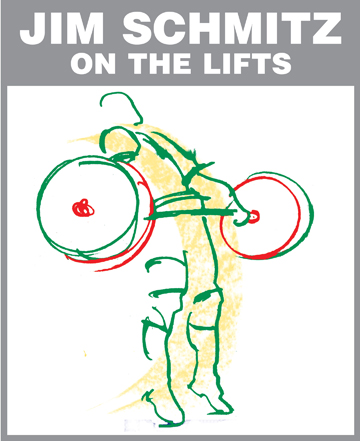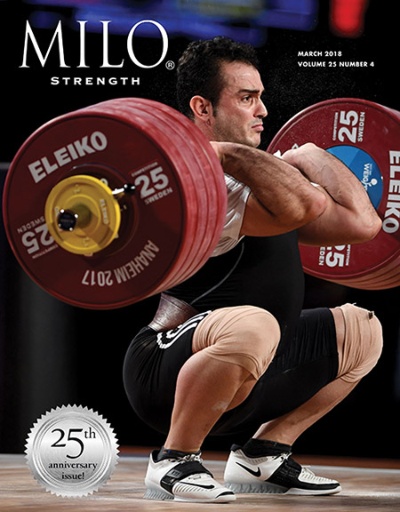
U.S. Olympic Weightlifting Team Coach 1980, 1988 & 1992 Author of Olympic-style Weightlifting for Beginner & Intermediate Weightlifters Manual and DVD
Do you ever wonder how lifts and exercises get their names and why? The Hack squat was named after the great strongman George Hackenschmidt. The Hack squat is performed by holding a barbell behind your back at about your glutes and squatting down and up. It was a widely performed exercise before squat and power racks came into being. The Zercher squat, done by holding a barbell in the crooks of your arms between your forearms and biceps, is named after Ed Zercher. And Zottman curls, where you curl dumbbells in a palms-up position, and then turn the dumbbells over and lower them in a reverse curl manner, are named after Otto Zottman. I could go on and on with examples, from the Romanian deadlift (aka RDL) to the Sots press. I've even named a couple of exercises after Olympic champions whom I've seen perform them: the Miyake snatch high pulls and the Sultan Rakhmanov good morning/squat, to name a few.
Have you heard of the lift called "Clarked?" It is an incomplete lift whereby when doing a clean you just pull the barbell to your belt or belly button and don't go for it. I hear "he (or she) Clarked it" whenever a lifter doesn't go for his clean. To Clark you have to pull up the barbell to at least your belly button; otherwise, it is a deadlift. The big difference between the two is that there is no effort when going for the clean with a deadlift, but with a Clark, it looks as if the lifter is going to go for it, but for some reason at the last moment he doesn't. I've heard it in gyms and compettiions from local to international, wherever English is spoken.
I've asked several lifters if they know the origin of the term and the lifters of today do not, so I will tell you. Ken Clark was one of my greatest weightlifters. He wandered into my gym, The Sports Palace, in San Francisco in October 1971 at 15 years old. Ken weighed 145 lb. (65 kg) and wanted to build himself up for football. To make a long story as short as possible, he went on to be national junior champion in 1974 and 1975 and placed sixth in the first Junior World Championships in 1975 with lifts of 120 kg and 152.5 kg in the 82.5-kg class. He went on to win six senior national championships with best lifts of 165 and 213 in the 100-kg class from 1981 to 1987. In 1982, and again in 1983, he needed U.S. national record clean and jerks of 210 and 212.5, respectively, in order to beat Richard Shanko for the national title. He made it both times and their competition was featured on ABC's Wide World of Sports. Ken placed tenth at the 1981 Worlds and sixth at the 1982 Worlds, so you see, Ken had quite a successful weightlifting career.
When the Soviets and the Eastern Bloc countries boycotted the 1984 Los Angeles Olympics in retaliation for the U.S. boycotting the 1980 Moscow Olympics, we thought Ken had a very good shot at a medal. However, at the competition Ken's second-attempt snatch with 160 was turned down two to one for press-out. We jumped to 162.5, trying to stay in the battle for a medal, but Ken missed it outright. We knew we had to total 367.5 kg to beat Niemi Pekka of Finland, who did that in the B session, as well as Canada's Kevin Roy, Sweden's Tom Soderlolm, and Nigeria's Oliver Orak, whom we were battling in the A session. With only 155 in the snatch, Ken felt his chances of a medal were very slim as his training for the clean and jerk hadn't gone very well in the last months of preparation for the Olympics. The strategy was to do 197.5, which he did, and then do 205 and then 212.5 kg for the bronze.
After the snatch I could see that Ken had lost some of his fire, so after an okay 197.5, he went for the 205 and only pulled it up to his belt buckle—a high pull without going for the clean. At the 1982 Worlds Ken did the same high pull with this 205 kg on his second attempt and then came back and made it on his third attempt. I was hoping for the same result here. He went for his third attempt and repeated the high pull to his belt buckle—and that is the origin of "Clarked." This is not an uncommon occurrence; you'll see it done at local meets to the Olympics. I don't know who first started calling the competition high pull a "Clark," but it was not too long after the 1984 Olympics. At first Ken and I were angered that people who weren't accomplished lifters would name an incomplete attempt after him.
At the 1985 Nationals, Ken went six for six, doing 145, 150, 155, 190, 195, and 200 kg and won his fifth Nationals. Ken won his sixth Nationals in 1987 and placed second in the 1987 Pan American Games and then retired after placing sixteenth in the 1990 Worlds in the 90-kg class. He got over his clean high pulls at the Olympics.
A few years ago I told Ken that lifters from Australia to Great Britain, and pretty much wherever English is spoken, are still referring to a clean high pull when attempting a clean as a "Clark." He laughed and said, "Well, how about that, I have a lift named after me!"
So there you have it, the origin of "Clark," as in, "He Clarked it." It was named after a great guy and a damn good weightlifter. And if you do a "Clark," don't quit or give up. Ken Clark never did, he just came back and made the lift—every time except at the 1984 Olympics.

















